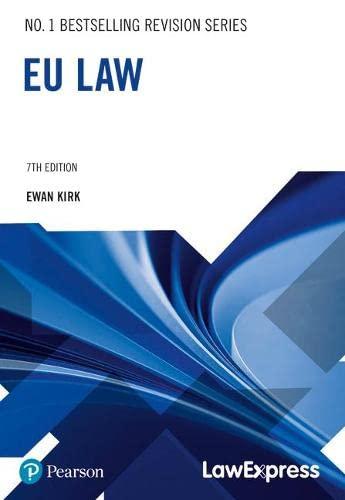Question
1. You task is to make an argument regarding whether the bubble regulation was a reasonable interpretation of the term stationary source in the Clean
1. You task is to make an argument regarding whether the bubble regulation was a reasonable interpretation of the term "stationary source" in the Clean Air Act. The issue here is what makes an administrative agency's interpretation of terms in an Act the agency is implementing reasonable.
2. The laws or rules you need to know has been listed after the description of the case. Administrative interpretation of laws is a very complex topic. You do not need to look for more rules for this assignment. The rules listed in the part Rules are all you need to know. In fact, some of those important rules are established after the decision of this case. You need not to worry about which rule(s) is(are) established before or after this case. You need only to focus on the arguments with the given rules.
3. The key to your argument is around what constitutes a reasonable interpretation of an Act by an administrative agency. You do not need use all the rules provided in the assignment. It is OK if you can make a beautiful argument with one rule.
4. The unanimous Supreme Court decision should not be afence that limits your conclusion to the conclusion of the Justice. Remember that Justices Thurgood Marshall, William H. Rehnquist, and Sandra Day O'Connor did not participate. They may have different opinion. You can still have your opinion even all of them have the same votes.
Facts of the case
The Clean Air Act (the Act) required states that had not yet achieved national air quality standards to establish a permit program regulating new or modified major stationary sources of air pollution, such as manufacturing plants. The Environmental Protection Agency (EPA) passed a regulation under the Act that allows states to treat all pollution-emitting devices in the same industrial grouping as though they were a single "bubble". Using this bubble provision, plants may install or modify one piece of equipment without needing a permit if the alteration does not increase the total emissions of the plant. Several environmental groups, including the Natural Resources Defense Council, challenged the bubble provision as contrary to the Act. The U.S. Court of Appeals for the D.C. Circuit set aside the EPA regulation as inappropriate for a program enacted to improve air quality.
Question that needs to be answered using IRAC Structure:
Does the Clean Air Act permit the EPA to define the term "stationary source" to mean whole industrial plants only, which allows plants to build or modify units within plants without the permit required under the Act?
Conclusion
Yes. Justice John Paul Stevens, writing for a unanimous court, reversed. The Supreme Court held that the bubble regulation was a reasonable interpretation of the term "stationary source" in the Clean Air Act. Congress did not have a specific intention for the interpretation of that term, and the EPA's regulation was a reasonable policy choice. The regulation also provided reasonable accommodations for the many competing interests affected by the Act. Justices Thurgood Marshall, William H. Rehnquist, and Sandra Day O'Connor did not participate.
Step by Step Solution
There are 3 Steps involved in it
Step: 1

Get Instant Access to Expert-Tailored Solutions
See step-by-step solutions with expert insights and AI powered tools for academic success
Step: 2

Step: 3

Ace Your Homework with AI
Get the answers you need in no time with our AI-driven, step-by-step assistance
Get Started


